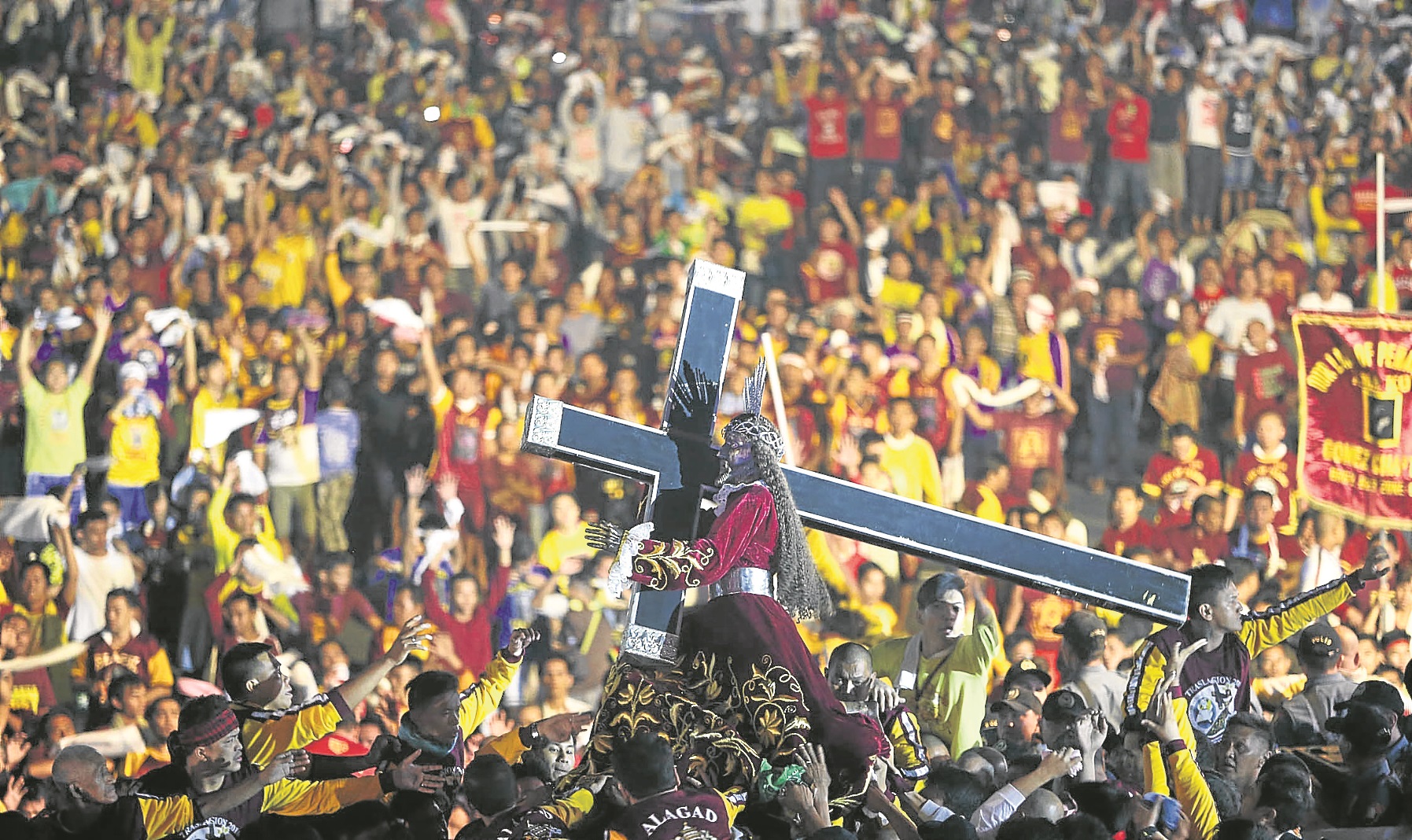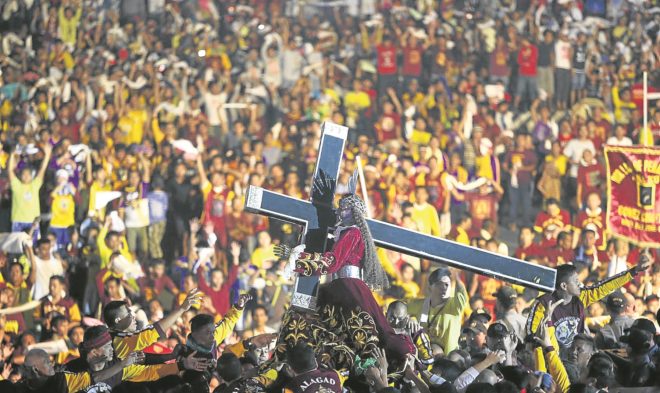The first myth to be cleared about the famous icon of the Black Nazarene of Quiapo, Manila, whose feast falls tomorrow (Jan. 9), is that it’s the biggest Catholic devotion in the Philippines.
The second myth to be cleared is that “Nuestro Padre Jesus Nazareno,” as the image is formally known, is the original icon now venerated by thousands upon thousands of Catholic devotees across the centuries.
The original icon was destroyed when World War II laid Intramuros to waste.
The third myth to be cleared is that the devotion is now more than 400 years old. The Quiapo clergy who mounted the fiesta in 2006 had billed the celebration as the “fourth centenary” of the icon.
No one knows when the devotion exactly started. But that’s getting ahead of the story.
Despite the hundreds of thousands who reportedly flock to Quiapo every January, “El Señor,” as the icon is nicknamed, is not the biggest Catholic devotion in the Philippines.
According to the late Dominican historian Fr. Fidel Villarroel, the biggest is that of, ironically, the diminutive Santo Niño, either the original icon in Cebu or its various replications in the Visayas and elsewhere, notably in Pandacan and Tondo in Manila.
Tondo’s Fiesta de Santo Niño even rivals in pomp and pageantry that of Quiapo’s. Incidentally, both feasts are celebrated on the same month.
Beginnings
Historians are at odds as to when the image of the Black Nazarene arrived in the country. But they agree that the original icon did not arrive with the first “barcada” or boatload of original Augustinian Recollect missionaries in 1606, as virtually claimed by the “quadricentenary” celebration in 2006.
Fernando Nakpil Zialcita of the Department of Sociology and Anthropology of Ateneo—himself a Quiapense—said he had yet to see documents relating to the exact date of arrival of the Black Nazarene. Augusto de Viana of the Department of History of the University of Santo Tomas noted the “conflict in the documents” regarding the arrival of the image.
Even the account of the first mission of the Augustinian Recollects to the country bore no record of any black image resembling the Señor.
The account was written by Fray San Jeronimo, one of the 10 priests and four brothers of the inaugural Recollect mission. He wrote that a May 1, 1605 royal decree from King Philip IV of Spain gave clearance to the Recollects to go to the Philippines. They left Cadiz on July 12, 1605, and arrived in San Juan de Ulua in Mexico on Sept. 17, 1605 to recharge. On Feb. 22, 1606, on board the ship “Espirito Santo,” they left Acapulco to sail for the Philippines.
Storms, challenges
In the middle of the Pacific, the ship faced innumerable challenges, including storms, which the Recollect missionaries attributed to lack of faith. The fathers then ordered everyone on the ship to confess and take the Holy Communion. Only then did the Pacific crossing went smoothly and without a chink.
It would have been the first miracle attributed to the Black Nazarene, except that there’s no record to show the icon was on board.
But to be sure, they prayed to the same Jesus Christ, who apparently granted their wish: for finally on May 10, 1606, the Augustinian “descalzados” safely set foot on Cebu.
The first mention relating to Quiapo, but not about the Black Nazarene, was when the Recollects occupied the convent that Governor General Pedro de Acuña gave to them as a gift. The church that the Recollects occupied in Intramuros was dedicated to St. John the Baptist, the patron saint of Quiapo Church today, and was inaugurated on Sept. 10, the feast day of St. Nicolas de Tolentino.
Intramuros, not Quiapo
Another convent was erected inside the Walled City. This time it was dedicated to St. Nicolas, upon the munificence of Don Bernardino del Castillo. But this structure was twice destroyed by natural disasters in the years 1645 and 1658. The Recollects then built another church that was to last until World War II.
It was in the Intramuros church that an intense devotion to the Nuestro Padre Jesus Nazareno, the original Nazareno, was given. But this was not the St. John the Baptist Parish Church that we see along Quezon Boulevard today.
The fierce devotion was even called a superstitious cult by Fr. Pedro Herce, a 20th-century Recollect historian. In his “The Recollects in the Philippines,” published in Boletin Ecclesiastico in 1965 of the Dominicans of the University of Santo Tomas, Herce also spoke of the Confraternity of Our Lord Jesus, formed to promote the devotion to the Nazareno on April 20, 1621.
According to the Parish of St. John the Baptist, Quiapo district was founded on Aug. 29, 1586, upon the orders of Governor General Santiago de Vera. But this church was built by the Franciscans, not the Recollects.
The patron saint of this parroquia was St. John the Baptist. But this church was destroyed during the Sangley (Chinese) revolution of 1603 and the earthquake of 1645.
Mexico
Regarding the exact date of and circumstances surrounding the arrival of Señor, historians could only surmise.
Zialcita and De Viana said it probably came from Mexico, having been carved by an Aztec artist who supposedly tinted it dark brown to liken it to the color of his race, mulatto, a hybrid.
It was probably through the Manila-Acapulco Galleon Trade that the Nazareno was brought to the country, said Zialcita.
However, when the Señor arrived in the 17th century, it was not brought to Quiapo, but to the Recollect church in Intramuros.
Meanwhile, the Cofradia de Jesus Nazareno was first mentioned in the 1650s, according to Zialcita. It was also at this time that the image of Señor arrived in the district, later on outranking in importance the devotion to St. John, to whom the church had been originally dedicated.
According to Zialcita, it was probably already in the 18th century, around 1760s, when the image of the Black Nazarene was brought down and installed in Quiapo.
According to “A Study on Filipino Culture: The Devotion to the Black Nazarene,” by M.M. Aguinaldo, the most probable date of installation of the Nazareno in Quiapo Church was 1767, when the image was blessed by Archbishop Basilio Sancho. And from this the torrid devotion of the hundreds of thousands of Filipinos to Nuestro Padre Jesus Nazareno started.
Macho Christ
Its dark image has intrigued historians and experts, but Zialcita and De Viana attributed the popularity of the icon to its unique color.
De Viana said the dark color is “the color of the masses and of the ordinary Juan de la Cruz.”
The color of the ordinary person, what a sight to behold! “No swagger, walang yabang,” said Zialcita, “walang angas.”
Though it is not a homegrown image, the Black Nazarene has been embraced “Filipino by Filipinos.”
Distinguished markedly from the usual image of Christ as suffering, crucified, wounded, with whip marks all over the body, and of passive mien with his head down, the Nazareno de Quiapo, said Zialcita, exudes a different impression.
This image is of the macho Christ, also suffering but not in the passive pose and countenance: he bears the black cross with strokes of gold on the four ends. This is the Christ with “pasan,” or if compared to ubiquitous jeepneys, with “pasada.”
The image shows off a brave front, something that will definitely click with patriarchal Filipinos, thus the dominance of male devotees. (It is only later when women joined the devotion, said Zialcita.)
Myth of fanaticism
There are actually two images of the Señor, the one in the high altar and the one in the chapel beside the church. Neither is the original.
Regardless, people will still continue to worship, revere and give votive prayers to the Black Christ. And they will show their worship and devotion in highly dramatic, some say fanatical, forms.
- Lynch, as cited by Aguinaldo, noted “the tendency (of Filipinos) to touch the object of one’s trust and affection is satisfied through the image.”
It’s part of the pageantry, according to Zialcita. This body-straining activity will really test the courage, patience and, most especially, the faith of a devotee.
And this is normal for Filipinos, said Zialcita, because “we are really physical in showing off our affection.” The hardships endured during the procession symbolize oneness with the suffering of Christ.
Zialcita vehemently disagreed that Filipinos’ devotion is “fanatical”; he even said the term is “very insulting.”
He explained that to call people’s devotion to the Nazarene fanatical means those labeling it as such are not taking a deeper look into the culture of the people. And this is the final myth to be demolished.
The Black Nazarene has united Filipinos across the centuries. Filipinos have related to the icon so much so that that the image has become their own identity and history. And that is no small miracle among several miracles attributed to El Señor across the centuries!













































